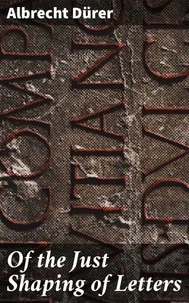Of the Just Shaping of Letters
Par : ,Formats :
Disponible dans votre compte client Decitre ou Furet du Nord dès validation de votre commande. Le format ePub est :
- Compatible avec une lecture sur My Vivlio (smartphone, tablette, ordinateur)
- Compatible avec une lecture sur liseuses Vivlio
- Pour les liseuses autres que Vivlio, vous devez utiliser le logiciel Adobe Digital Edition. Non compatible avec la lecture sur les liseuses Kindle, Remarkable et Sony
 , qui est-ce ?
, qui est-ce ?Notre partenaire de plateforme de lecture numérique où vous retrouverez l'ensemble de vos ebooks gratuitement
Pour en savoir plus sur nos ebooks, consultez notre aide en ligne ici
- Nombre de pages43
- FormatePub
- ISBN859-65--4732776-9
- EAN8596547327769
- Date de parution16/09/2022
- Protection num.Digital Watermarking
- Taille1 Mo
- Infos supplémentairesepub
- ÉditeurDIGICAT
Résumé
In "Of the Just Shaping of Letters, " Albrecht Dürer meticulously explores the principles and aesthetics of typography, melding artistic vision with mathematical precision. Written during the height of the Renaissance, Dürer's work reflects the profound intellectual currents of the time, particularly the interplay between art, science, and humanism. The text delves into the essential elements of letterforms, advocating for a harmonious balance between beauty and function, while demonstrating his argument through elegant illustrations and detailed analysis.
It serves not only as a guide for artisans but also as an artistic manifesto rooted in Dürer's faith in rationality and proportion. Albrecht Dürer, a pivotal figure in Northern Renaissance art, was influenced by the classical ideals of ancient Rome and Greece as well as contemporary developments in printmaking. His extensive travels and interactions with Italian artists enriched his understanding of art and design, which culminated in this significant work.
Dürer's background as a painter, engraver, and theorist informed his innovative approach to typography, merging artisanal craftsmanship with scholarly inquiry. Readers interested in design, typography, or the interplay between art and science will find "Of the Just Shaping of Letters" an invaluable resource. Dürer's illuminating insights evoke a timeless appreciation for letterform design, making this work essential reading for artists, historians, and anyone captivated by the beauty of written language.
It serves not only as a guide for artisans but also as an artistic manifesto rooted in Dürer's faith in rationality and proportion. Albrecht Dürer, a pivotal figure in Northern Renaissance art, was influenced by the classical ideals of ancient Rome and Greece as well as contemporary developments in printmaking. His extensive travels and interactions with Italian artists enriched his understanding of art and design, which culminated in this significant work.
Dürer's background as a painter, engraver, and theorist informed his innovative approach to typography, merging artisanal craftsmanship with scholarly inquiry. Readers interested in design, typography, or the interplay between art and science will find "Of the Just Shaping of Letters" an invaluable resource. Dürer's illuminating insights evoke a timeless appreciation for letterform design, making this work essential reading for artists, historians, and anyone captivated by the beauty of written language.
In "Of the Just Shaping of Letters, " Albrecht Dürer meticulously explores the principles and aesthetics of typography, melding artistic vision with mathematical precision. Written during the height of the Renaissance, Dürer's work reflects the profound intellectual currents of the time, particularly the interplay between art, science, and humanism. The text delves into the essential elements of letterforms, advocating for a harmonious balance between beauty and function, while demonstrating his argument through elegant illustrations and detailed analysis.
It serves not only as a guide for artisans but also as an artistic manifesto rooted in Dürer's faith in rationality and proportion. Albrecht Dürer, a pivotal figure in Northern Renaissance art, was influenced by the classical ideals of ancient Rome and Greece as well as contemporary developments in printmaking. His extensive travels and interactions with Italian artists enriched his understanding of art and design, which culminated in this significant work.
Dürer's background as a painter, engraver, and theorist informed his innovative approach to typography, merging artisanal craftsmanship with scholarly inquiry. Readers interested in design, typography, or the interplay between art and science will find "Of the Just Shaping of Letters" an invaluable resource. Dürer's illuminating insights evoke a timeless appreciation for letterform design, making this work essential reading for artists, historians, and anyone captivated by the beauty of written language.
It serves not only as a guide for artisans but also as an artistic manifesto rooted in Dürer's faith in rationality and proportion. Albrecht Dürer, a pivotal figure in Northern Renaissance art, was influenced by the classical ideals of ancient Rome and Greece as well as contemporary developments in printmaking. His extensive travels and interactions with Italian artists enriched his understanding of art and design, which culminated in this significant work.
Dürer's background as a painter, engraver, and theorist informed his innovative approach to typography, merging artisanal craftsmanship with scholarly inquiry. Readers interested in design, typography, or the interplay between art and science will find "Of the Just Shaping of Letters" an invaluable resource. Dürer's illuminating insights evoke a timeless appreciation for letterform design, making this work essential reading for artists, historians, and anyone captivated by the beauty of written language.



